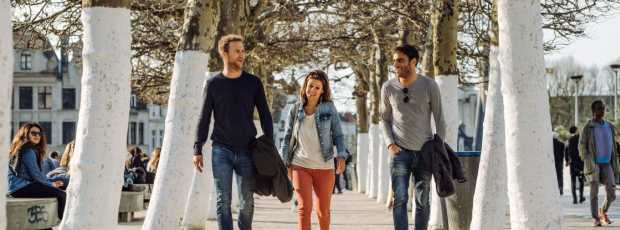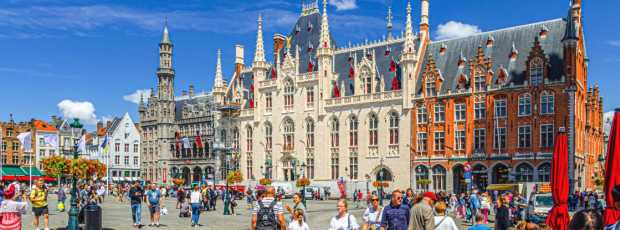Table Of Contents
- Why November is Actually Brussels' Best-Kept Secret
- What Makes Brussels Museums Different in November?
- Is Grand Place Worth Visiting in November Weather?
- Where Should You Go When It's Pouring?
- How Do Brussels Locals Spend November Afternoons?
- Are Brussels Christmas Markets Worth the November Hype?
- What's the Story About Brussels Art Nouveau Architecture?
- How Do You Navigate Brussels on a November Day Trip?
- Where Can You Find Authentic Brussels Experiences?
- Is November Weather That Bad for Sightseeing?
- What About Food and Drink in November Brussels?
- How to Make the Most of Short November Days?
- Planning Your November Brussels Experience
November in Brussels isn't the month travel brochures celebrate. The tourists have retreated, the leaves have surrendered to the pavement, and yes, it rains. But here's what those glossy guides miss: this is when the city becomes itself again. When you're looking for authentic things to do in Brussels in November, you're getting the real deal; museums without queues, cafés full of locals, and that particular magic that emerges when weather forces everyone indoors together.
I've lived here long enough to know that November rewards the curious. The city sheds its summer performance and settles into something more honest. The Grand Place gleams differently in autumn drizzle, the chocolate shops become refuges, and suddenly those indoor attractions everyone skips in July become essential. Visiting Belgium during this season means experiencing Belgian culture at its most authentic.
Why November is Actually Brussels' Best-Kept Secret
Most visitors write off November as "shoulder season", that polite tourism term for "not ideal." They're missing the point entirely. This is when Central Brussels exhales. The city center empties of sightseeing bus crowds and selfie sticks, leaving space for discovery. Average temperatures hover around 8°C, creating that perfect excuse for café culture.
The weather becomes atmospheric rather than obstacle. Morning fog clings to our UNESCO World Heritage Site, the Grand Place like a scene from a Magritte painting. The cobblestones reflect streetlights in ways that make even jaded locals pause. When rain starts (which it will) you're not battling crowds to duck into that café or museum. This small country offers concentrated cultural density impossible to replicate elsewhere.
Public transport runs efficiently regardless of weather, and Brussels remains well connected to other cities throughout Europe. Our infrastructure was designed for exactly these conditions.
Takeaway: November transforms Brussels from tourist destination to authentic urban experience.
What Makes Brussels Museums Different in November?
When you visit Brussels, visiting museums becomes contemplative. The Magritte Museum houses the world's largest collection of the surrealist's work, and without summer crowds, you can actually stand before "The Treachery of Images" and think. The heating creates warmth that feels like intellectual comfort food. In November's muted light, those impossible skies feel particularly relevant.
The Fine Arts complex (Royal Museums of Fine Arts of Belgium) nearby transforms too. These Royal Museums split across multiple buildings, but November makes the underground connection feel like a secret tunnel through culture. The Flemish masters gallery takes different weight when autumn light filters through skylights. Interactive elements throughout enhance the experience, while an audio guide option provides deeper context.
Comic strip culture thrives year-round, but November gives the Comics Museum breathing room. Belgium practically invented the ninth art, and this museum proves it. The Art Nouveau style building housing the collection becomes part of the story, Victor Horta's ironwork echoing the fluid lines of Hergé's characters.
The Musical Instruments Museum offers an impressive collection spanning centuries. Its top floor café provides panoramic city views while you warm up between exhibits. The entrance fee represents great value considering the treasure trove of artifacts and interactive elements available.
Takeaway: November museum visits offer contemplative experiences impossible during peak season.
Looking for a private city experience in Brussels?
Explore the city with a local who plans a private day just for you; no groups, no scripts.
Is Grand Place Worth Visiting in November Weather?
Our UNESCO World Heritage Site becomes theater in November. Morning mist rises from cobblestones, softening the gothic architecture of guildhalls into something mystical. The Brussels Town Hall looks particularly dramatic when fog clings to its spire, less tourist postcard, more atmospheric film set.
Early November mornings are prime time. The Grand Place belongs to locals heading to work, delivery trucks serving surrounding cafés, and occasional photographers who understand lighting. The guildhalls' gold details catch whatever light penetrates clouds, creating moments of unexpected beauty rooted in European history dating to the Middle Ages.
Evening transforms the space entirely. The Brussels Town Hall illuminated against dark November skies creates that particular drama Americans pay good money to experience. Surrounding cafés spill warm light onto wet cobblestones, and suddenly you understand why this square made UNESCO's list. This wonderful place showcases historic architecture at its finest.
Takeaway: Grand Place in November offers atmospheric drama impossible in clearer weather.
Where Should You Go When It's Pouring?
When rain commits, and in November, it does, Brussels reveals its indoor soul. Things to do in Brussels when it rains isn't backup plan; it's the main event designed by urban planners who understood our climate.
The underground museum network connecting Royal collections creates a climate-controlled cultural universe. You can spend hours moving between impressive collection displays without encountering the weather. The basement level houses some of Magritte's most unsettling work, perfect for grey November contemplation.
Galeries Royales Saint-Hubert becomes essential. These 19th-century shopping arcades were built for this weather. Glass ceilings protect you while maintaining an urban exploration sense. The chocolate shops here aren't tourist traps, they're necessities. Belgian chocolate makers like Laurent Gerbaud understand November's demands, offering sweet treat options that function as comfort food.
Mont des Arts offers covered passages and heated cultural institutions. The name means "mount of arts," but locals know it as the place where you can duck between attractions without getting soaked. The viewpoint over the city becomes particularly moody in November weather.
Takeaway: November rain opens indoor cultural networks designed for exactly these conditions.
How Do Brussels Locals Spend November Afternoons?
We embrace the ritual of extended café afternoons. We choose cafés with proper heating, good lighting for reading, and staff who understand that hot chocolate orders aren't rushed affairs during the approaching Christmas season.
Delirium Café becomes refuge, though we avoid it during tourist season. In November, it returns to neighborhood status. The beer selection remains overwhelming, but crowds thin to manageable proportions. Similarly, cafés around Place de la Monnaie recover their local character.
Shopping becomes art form. The Sablon district transforms in November; antique shops, chocolate boutiques, and galleries create natural progression through covered passages. Chocolate shopping becomes less about souvenirs, more about survival supplies and understanding our Belgian culture.
The Marolles flea market continues regardless of weather. November vendors are dedicated ones, selling everything from fixtures to vintage comic strips. It's walking distance from the city center, and covered sections provide weather protection while maintaining authentic Brussels market atmosphere.
Takeaway: November locals prioritize indoor comfort and authentic neighborhood experiences over tourist activities.
What if your day in Brussels was planned by someone who knows it — and you?
City Unscripted matches you with a local host who creates a private experience based on your interests, not a set route.
Are Brussels Christmas Markets Worth the November Hype?
The Christmas season starts early here, usually mid-November, and locals have complicated feelings about it. The main market at Place Sainte-Catherine transforms the neighborhood, not always for better. However, November offers the sweet spot; markets open, crowds manageable.
The stalls serve delicious food that makes November weather bearable: proper Belgian waffles, mulled wine, and winter comfort foods locals eat. Fresh fruit vendors adapt their offerings to seasonal availability. Timing matters, weeknight evenings offer atmosphere without weekend chaos.
Place Eugène Flagey hosts a smaller market locals prefer. Less commercial, more neighborhood-focused, with vendors selling crafts rather than mass-produced decorations. The surrounding Art Deco historic architecture creates sophisticated backdrop than usual medieval tourist marketing.
Some markets include ice skating rinks, though November weather makes these experiences more about atmosphere than skating. The whole family can find activities suitable for various ages and interests.
Takeaway: November Christmas markets offer authentic seasonal atmosphere before tourist crowds arrive.
What's the Story About Brussels Art Nouveau Architecture?
November weather enhances Art Nouveau style appreciation. The iron and glass constructions that Victor Horta and others designed for Belgian climate show their purpose in autumn conditions. Natural light becomes precious, so those innovative window designs and stained glass windows prove their function.
The Horta Museum requires advance planning (it's small and popular) but November increases your chances. His private residence showcases how Art Nouveau solved practical problems: maximizing light, creating indoor/outdoor flow, making small spaces feel expansive. Essential when spending more time indoors during visiting Belgium experiences.
Walking tours of Art Nouveau districts work better in November than summer. Trees are bare, revealing building details hidden by leaves. Reduced daylight forces attention to architectural elements rather than surrounding distractions. The houses look inhabited rather than museum pieces, showing how this historic architecture functions in daily life.
Takeaway: November weather reveals the functional brilliance of Brussels' Art Nouveau architecture.
How Do You Navigate Brussels on a November Day Trip?
A day trip to Brussels in November requires strategy. The train station (Central Station) connects directly to center via covered passages, essential knowledge when planning logistics. November weather makes surface travel between top attractions less appealing, so understanding underground connections matters.
The Royal Museums create cultural circuit: surrealist collections, fine arts, and temporary exhibitions, all climate-controlled and interconnected. This forms half a day minimum, leaving time for the Grand Place and surrounding areas. The Brussels Card provides access to multiple venues plus public transport, representing excellent great value for first visit experiences.
Comic strips culture demands at least one stop, either the dedicated museum or outdoor murals scattered through the city. November light actually enhances these wall paintings, reducing glare and tourist crowds around famous ones. The museum offers interactive elements that engage the whole family.
Food planning becomes crucial. Delicious food in Brussels means understanding local timing, lunch happens, dinner starts late. November weather makes restaurant reservations more important, as locals seek indoor comfort too.
Takeaway: November day trips succeed through indoor cultural circuits and advance planning.
Tip
We match you with the right host, not just any guide.Want to experience the real Brussels with someone who lives there?
A fully private experience, planned and led by a local host who tailors the day to you
Where Can You Find Authentic Brussels Experiences?
Visit Brussels marketing focuses on obvious attractions, but November reveals authentic layers. The Grand Place remains essential, but surrounding streets; Rue des Bouchers, Petite Rue des Bouchers, show how locals actually use the city center. At first glance, these might seem purely commercial, but November reveals their neighborhood function.
The Marolles district becomes particularly authentic in November. Fewer tourists venture into this working-class neighborhood when weather turns, leaving space for actual community interaction. The daily market continues regardless of conditions, and surrounding cafés serve locals, not visitors. This area showcases Belgian culture without tourist gloss.
Historic architecture tours work better as self-guided exploration in November. The Ixelles and Uccle districts showcase residential examples without tourist infrastructure—you're seeing how people actually live in historically significant buildings designed during various periods of European history.
Parc du Cinquantenaire offers indoor museum options when weather prevents outdoor exploration. The complex houses multiple museums, including the Military Museum with its impressive collection spanning centuries of conflict and musical instruments from various periods.
Takeaway: November strips away tourist veneer, revealing authentic neighborhood life.
Is November Weather That Bad for Sightseeing?
The weather becomes part of the experience rather than obstacle. Brussels was built for this climate, covered passages, heated cafés, interconnected cultural institutions. November weather forces you to experience the city as locals do: strategically, selectively, with proper appreciation for indoor comfort.
The winter season brings specific advantages: museums less crowded, restaurants more available, locals more willing to engage with visitors who've chosen to experience their city in authentic conditions. The rain stops eventually (usually) and when it does, those dramatic skies over gothic architecture create moments impossible in clearer weather.
Interesting museums become refuges rather than obligations. Cultural collections feel different when you're genuinely seeking shelter rather than checking items off lists. The comic strips displays make more sense when you understand Belgian indoor culture and why the ninth art developed such prominence here.
Mini Europe remains operational year-round, though November visits require weather preparation. This miniature park showcasing European landmarks offers indoor viewing areas and covered walkways between major displays.
Takeaway: November weather enhances rather than hinders authentic cultural experiences.
What About Food and Drink in November Brussels?
November dining becomes serious business. Hot chocolate isn't tourist novelty, it's survival tool and sweet treat combined. Places like Pierre Marcolini or Wittamer create versions that function as afternoon fuel and cultural experience simultaneously. Belgian chocolate shops transform from gift-purchasing stops to essential neighborhood services.
Beer culture shifts too. Summer terraces close, pushing activity indoors to proper café culture. Delirium's thousand-beer selection makes more sense when spending extended time indoors. Cantillon Brewery offers tours year-round, but November visits feel more intimate; fewer crowds, more attention to actual brewing process reflecting centuries of Belgian culture.
Delicious food means understanding seasonal availability. November brings game season, root vegetables, and those heavy comfort foods that make perfect sense in this weather. Restaurants adapt menus accordingly, showcasing ingredients and preparation methods rooted in European history.
Street food continues despite weather. Frites stands remain operational, and November actually improves the experience; hot food on cold streets, steaming paper cones creating temporary warmth. These vendors offer more than tourist snacks; they're part of daily Belgian life.
Takeaway: November transforms food culture from tourist sampling to local comfort and survival.
Ready to plan your perfect day in Brussels?
Start your experienceHow to Make the Most of Short November Days?
Daylight becomes precious in November Brussels, requiring strategic planning. Museums open early—cultural collections maximize limited natural light through skylights and window placement. Plan cultural visits for mid-morning through early afternoon when available light enhances the experience. Many venues offer audio guide options that work particularly well during shorter viewing windows.
Evening activities shift indoors by necessity. The Christmas market stalls provide outdoor atmosphere with heating and covered areas. Place de la Monnaie transforms after dark; the opera house and surrounding cafés create sophisticated evening options independent of weather.
Late afternoon becomes prime time for café culture. Walking distance between major sites means you can duck indoors when weather demands, then emerge for short outdoor segments between destinations. The interconnected nature of Central Brussels makes this practical rather than theoretical.
Popular attractions adapt their schedules and services for November conditions. Many offer extended evening hours or special programming designed for winter season visitors seeking indoor cultural experiences.
Takeaway: November's short days require strategic timing but reward careful planning with intimate cultural experiences.
Planning Your November Brussels Experience
Things to do in Brussels November requires accepting rather than fighting the season. This isn't summer with rain; it's a different city entirely, one that rewards indoor exploration, cultural depth, and authentic local interaction. For your first visit, this might seem counterintuitive, but November offers advantages impossible during peak season.
The infrastructure supports this perfectly. From train station connections to museum networks, covered passages to heated cafés, Brussels designed itself for exactly this weather. November visitors experience the city as meant to be used: strategically, thoughtfully, with proper appreciation for comfort and culture.
Whether planning a day trip or extended stay, November Brussels offers something impossible in other seasons: authenticity without performance, culture without crowds, and that particular urban intimacy that emerges when weather forces a city inward. This wonderful place becomes more itself rather than less.
Brussels experiences vary dramatically by season, but November provides perhaps the most honest version; challenging enough to deter casual visitors, rewarding enough to create lasting memories for those who embrace it. The entrance fee to major attractions represents better great value when you're not competing with crowds for attention and space.
The key to successful activities in Brussels in November lies in understanding this isn't compromise weather; it's reveal-the-real-city weather. Come prepared for rain, plan for indoor culture, expect authentic neighborhood interaction, and discover why some of us prefer Brussels exactly like this: honest, atmospheric, and genuinely itself. This small country offers concentrated experiences that larger destinations struggle to match, particularly when weather strips away the superficial and reveals the substantial.
What if your day in Brussels was planned by someone who knows it — and you?
City Unscripted matches you with a local host who creates a private experience based on your interests, not a set route.
Want to experience the real Brussels with someone who lives there?
A fully private experience, planned and led by a local host who tailors the day to you











